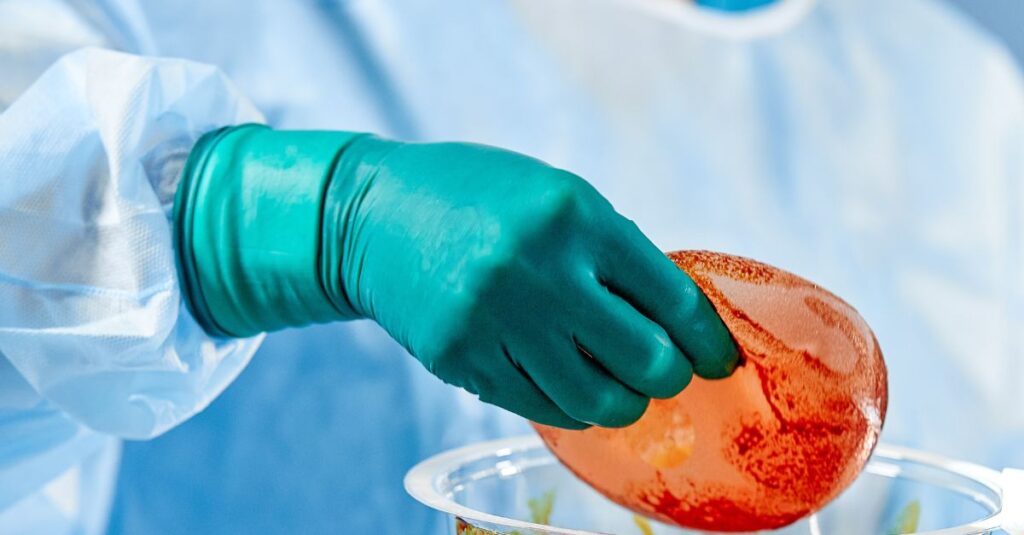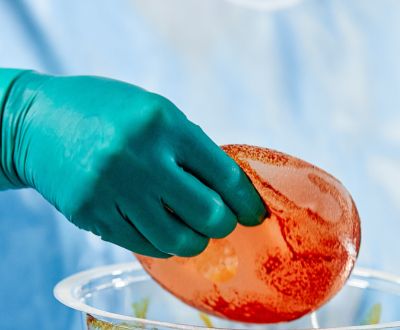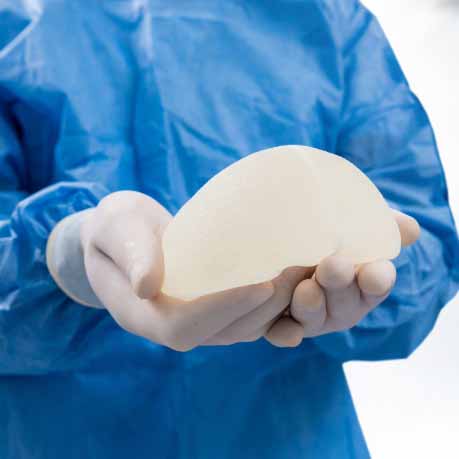Breast Implant Rupture
Risks and Complications – Breast Augmentation
Breast Implant Rupture

All implantable medical devices have a limited life span after which the probability of device failure rises. While modern breast implants are very safe, they too should not be considered definitive. Failure of a breast implant is generally defined as loss of external envelope integrity with spillage of the implant contents. The external envelope may fail due to a direct traumatic force resulting in a tear to the surface of the implant. This is an unusual cause of implant failure and is always preceded by an identifiable event such as seen with blunt force trauma to the chest in a motor vehicle accident or following penetrating trauma that pierces both the breast and implant.
Implant failure is more likely to be insidious and arise without an obvious preceding event. It is believed that material fatigue from the cumulative repeated bending and folding of the implant over time may lead to cracks and ultimately disruption of the external envelope of a breast implant. Previous models of breast implants fabricated with thin external rubber envelopes were particularly susceptible to progressive wear and failure. The current generation of breast implants has been re-engineered with very durable external envelopes to better tolerate the cyclical bending expected of the implant after breast augmentation. The probability of failure is low.
Saline implant: The external envelope of a saline breast implant has the added complexity of a fill valve that is not present in fixed-volume silicone gel implants. Failure of saline breast implants may occur due to valve failure or fracture of the implant envelope. The spilled saline content of the implant is then resorbed by the body leading to loss of breast volume and deflation. Valve failure of a saline implant will usually present as partial deflation that is progressive over a prolonged period of time. In contrast, fracture and disruption of the exterior envelope of the implant result in rapid and total deflation often complete within one day.
Silicone gel implant: In general, silicone gel implants have a lower risk of rupture. Even with external envelope disruption, the cohesive silicone gel may remain confined within the body’s fibrous capsular tissue pocket surrounding the breast implant. This has been medically coined “intracapsular rupture”. Penetration of the silicone gel into the surrounding tissue, called “extracapsular rupture”, is an unusual event with the modern “cohesive” properties of silicone gel polymers used in present-day breast implants. Loss of breast volume does not occur and patients are often without symptoms. The ruptured silicone implant is often coincidentally detected during routine breast screens and mammograms. Ruptured silicone breast implants have been associated with a higher rate of capsular contracture.
Dr. Chen Lee strongly recommends the exchange or removal of extracapsular ruptured silicone breast implants. Management of an asymptomatic intracapsular rupture of a silicone breast implant is more controversial. Although Dr. Chen Lee favors the exchange or removal of intracapsular ruptured implants, there is enough variability in management to consider radiographic surveillance.
Risk of breast implant rupture: Currently, statistical data is not available on breast implant rupture rates. Improved material science and advanced implant design have provided theoretical benefits to implant durability and longevity. Silicone gel implants are manufactured with dense viscous filler that lubricates and reduces mechanical stress on the external implant envelope. The reduction in stress should enhance the longevity of silicone gel-filled implants. In contrast, the saline solution does not impart the same protective properties to the saline-filled implant envelope and is postulated to have a higher likelihood of failure.
Symptoms resulting from breast implant rupture: Rupture of a saline-filled implant will lead to loss of breast volume. Spillage of the saline from the ruptured implant is rapidly resorbed and eliminated by the body. The rupture of a silicone-filled implant can be completely asymptomatic and go undetected for long durations of time. Most cases of silicone implant rupture are diagnosed coincidentally during routine breast screening studies and mammograms.
Following rupture, is there an urgency to manage this complication?: Following rupture, it may be in your best interest to seek an expeditious surgical correction. Delay in managing a ruptured saline implant may result in contraction of the implant pocket from the loss of volume. Postponement of surgery for a ruptured silicone implant may exacerbate silicone migration into tissues. Such delays may complicate management and jeopardize attempts to salvage your breast augmentation.
Next Steps…
To learn more about a procedure or book a consultation








